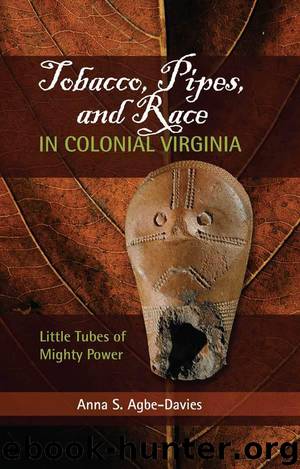Tobacco, Pipes, and Race in Colonial Virginia: Little Tubes of Mighty Power by Agbe-Davies Anna S

Author:Agbe-Davies, Anna S [Agbe-Davies, Anna S]
Language: eng
Format: azw3
ISBN: 9781315416670
Publisher: Taylor and Francis
Published: 2016-06-03T04:00:00+00:00
“Jamestown” as a Category
Another angle from which to approach the pipe fragments from Jamestown is to group them. Here, I analyze these artifacts as one assemblage among six, the other five being the plantations from Chapter 3. This analysis reveals the extent to which these sites are really different from each other. Once the extent of difference among the six sites is established, it can be used as a baseline for the final comparison, in which I consider whether the Jamestown assemblage is viable as a category (urban?) to be contrasted with another which includes all of the plantations (rural?).
Some of the variation among sites/structures is random, but most clearly isn’t. The only variable for which we see no significant difference among the six sites—Green Spring, Drummond, Rich Neck, Page, Port Anne, and Jamestown—is the presence or absence of white paint or slip. A similar picture emerges when one compares individual sites or structures to the overall assemblage. (The details for this variable are shown in Table 4.2, and repeated again in Table 4.3). So the white slip, which has received much attention (Emerson 1999; Mouer et al. 1999), appears to be randomly distributed across the sites and not characteristic of any particular pipe assemblage(s). The white slip is something of an anomaly, though; many other attributes do discriminate effectively among the sites and structures. The distribution of modes, representing both decorative and technological style, is not random, but patterned.
Whether the attributes are related to materials, techniques of manufacture, shape, or decorative style, the sites—including Jamestown—do seem to be meaningful units of pipe style. The first column of Table 4.3 shows all of the attributes for which the sites differ significantly from each other. The “Ns” in the third column, for “no significant difference,” show that the Jamestown structures are more similar to each other than the six
Table 4.2 The chi-square statistic shows that presence or absence white paint or slip decoration does not adequately distinguish among the pipe fragments from the six sites studied here(x2= 10.97, df = 5, p > 0.05). The difference between round heels and square heels does vary significantly among the Jamestown structures (x2 = 30.654, df = 5, p < 0.001; note: the expected values are quite low, meaning that the true significance is debatable).
Download
This site does not store any files on its server. We only index and link to content provided by other sites. Please contact the content providers to delete copyright contents if any and email us, we'll remove relevant links or contents immediately.
The Vikings: Conquering England, France, and Ireland by Wernick Robert(79855)
Ali Pasha, Lion of Ioannina by Eugenia Russell & Eugenia Russell(40122)
The Conquerors (The Winning of America Series Book 3) by Eckert Allan W(37100)
The Vikings: Discoverers of a New World by Wernick Robert(36905)
Cecilia; Or, Memoirs of an Heiress — Volume 1 by Fanny Burney(32405)
Cecilia; Or, Memoirs of an Heiress — Volume 3 by Fanny Burney(31808)
Cecilia; Or, Memoirs of an Heiress — Volume 2 by Fanny Burney(31781)
Empire of the Sikhs by Patwant Singh(22952)
The Secret History by Donna Tartt(18798)
Hans Sturm: A Soldier's Odyssey on the Eastern Front by Gordon Williamson(18452)
Cat's cradle by Kurt Vonnegut(15140)
Pimp by Iceberg Slim(14297)
Sapiens: A Brief History of Humankind by Yuval Noah Harari(14201)
Talking to Strangers by Malcolm Gladwell(13178)
Norse Mythology by Gaiman Neil(13161)
Leonardo da Vinci by Walter Isaacson(13136)
4 3 2 1: A Novel by Paul Auster(12255)
Underground: A Human History of the Worlds Beneath Our Feet by Will Hunt(11993)
The Radium Girls by Kate Moore(11895)
